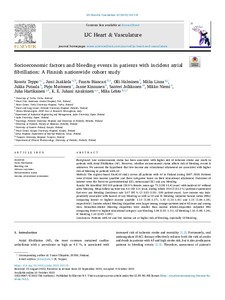Socioeconomic factors and bleeding events in patients with incident atrial fibrillation: A Finnish nationwide cohort study
Niemi Mikko; Halminen Olli; Teppo Konsta; Jaakkola Jussi; Linna Miika; Lehto Mika; Airaksinen KE Juhani; Jolkkonen Santeri; Biancari Fausto; Putaala Jukka; Hartikainen Juha; Mustonen Pirjo; Kinnunen Janne
https://urn.fi/URN:NBN:fi-fe2022112967829
Tiivistelmä
Background
Low socioeconomic status has been associated with higher risk of ischemic stroke and death in patients with atrial fibrillation (AF). However, whether socioeconomic status affects risk of bleeding events is unknown. We assessed the hypothesis that low income and educational attainment are associated with higher risk of bleeding in patients with AF.
Methods
The registry-based FinACAF study covers all patients with AF in Finland during 2007-2018. Patients were divided into income quartiles and three categories based on their educational attainment. Outcomes of interest were the first-ever gastrointestinal (GI), intracranial (IC) and any bleeding.
Results
We identified 205 019 patients (50.9 % female; mean age 72.3 (SD 13.4) years) with incident AF without prior bleeding. Mean follow-up time was 4.0 (SD 3.2) years, during which 25 013 (12.2 %) patients experienced first-ever any bleeding (incidence rate 3.07 (95 % CI 3.03-3.10) /100 patient-years). Low income was independently associated with hazard of any bleeding as well as GI and IC bleeding (adjusted hazard ratios (HRs) comparing lowest vs highest income quartile: 1.13 (1.08-1.17), 1.32 (1.23-1.41) and 1.15 (1.06-1.24), respectively). Income-related bleeding disparities were larger among younger patients under 65 years and among men. Education-related bleeding disparities were smaller than income related-disparities (adjusted HRs comparing lowest vs highest educational category: any bleeding 1.06 (1.02-1.11), GI bleeding 1.16 (1.08-1.24), IC bleeding 1.10 (0.93-1.09)).
Conclusions
Patients with AF and low income are at higher risk of bleeding, especially GI bleeding.
Kokoelmat
- Rinnakkaistallenteet [19207]
